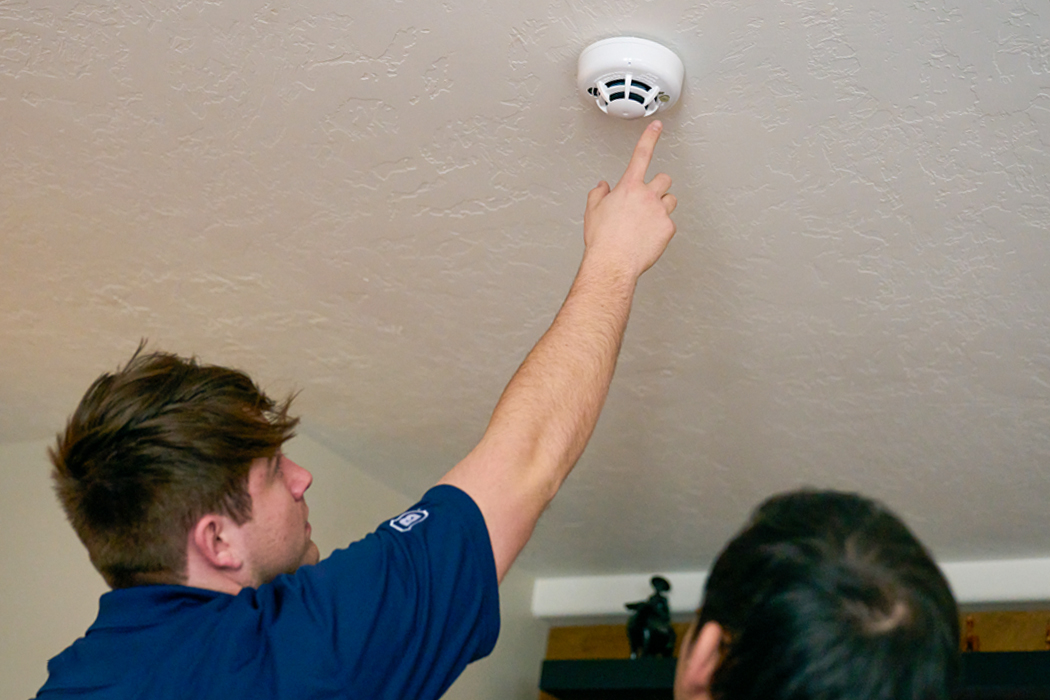How Many Carbon Monoxide Detectors Should You Have?

The number of carbon monoxide (CO) detectors required in your home will depend on several factors. You’ll need to consider the size of your home, and the number of bedrooms. It is very common for homeowners to place carbon monoxide detectors incorrectly, so it’s also very important you follow all manufacturer recommendations.
Carbon Monoxide Total Home Protection
At the very least, you’ll need a detector for each level of the home. This includes the basement too, since you many have appliances in the basement like a furnace or gas dryer. For bedrooms, the United States Consumer Product Safety Commission (CPSC) recommends the following:
Shape
“CO alarms should be installed on each level of the home and outside sleeping areas. Smoke alarms should be on every level of the home, outside sleeping areas and inside each bedroom.”
However, the CPSC does not recommend the placement of carbon monoxide detectors in the attic of a home.
Another area to place a carbon monoxide detector is nearby an attached garage, but it’s important to know the difference between carbon monoxide and carbon dioxide. Within the garage, vehicles can produce dangerous chemicals that can seep into the house. If you’re ever unsure of whether or not you need an alarm in a particular area, err on the side of caution. If possible, purchase extra CO detector, as peace of mind may be worth a little extra expense.
One thing to keep in mind is that you will place a carbon monoxide detector at a different level than a smoke detector. Smoke detectors are typically placed on ceilings because heat rises. Carbon monoxide mixes in with fresh air. Placing them level with your bed is a good option since you’re most vulnerable to carbon monoxide poisoning when you’re sleeping. If you have children who may be curious about the detector, you can set it higher on the wall, at eye level.
Places to Avoid
Certain areas of the home could cause false readings from the carbon monoxide detectors. You should not place a carbon monoxide detector in any of the following:
Bathrooms
Next to heating appliances
Near fireplaces
Next to open windows
Although you want to place a carbon monoxide detector within the general area of an appliance burning fossil fuels, it should still be a minimum of 15 feet away from the unit. You’ll also want to keep the detectors out of reach of children to avoid any malfunctions.
How to Install a Carbon Monoxide Detector and Other Tips
Knowing how many CO detectors you should have inside your home is one thing. But, maintaining the detector so it can protect you and your loved ones for a long time, is another.
As mentioned before, you should not install your CO detectors the same way you would a smoke detector. These devices aren’t for placing on the ceiling. Instead, install your carbon monoxide detectors at knee-height or eye-level, at maximum. If you still have concerns about the installation process, refer to your detector’s user manual for further guidance.
We also suggest homeowners should shop around for CO detectors to make sure the detector is UL approved. UL approved devices give off a green light meaning the device has met stringent safety requirements.
3 Easy Ways You Can Maintain Your CO Detector
Make sure your carbon monoxide detector can withstand the test of time with:
Cleaning
Fresh batteries
Routine testing
Cleaning Your CO Detector
Cleaning your detector is one of the most effective ways you can care for the device. Dust, debris, and dirt can clog your detector, making it difficult for the device to monitor your home. The easiest way to dust your detector is to use a soft cloth or the brush attached to your vacuum cleaner.
Switch Out the Batteries
A carbon monoxide detector can best monitor your home when it has working batteries. Be sure to replace them with each seasonal time change to avoid issues with the functionality of the detector.
Give it a Test
You should test your carbon monoxide detector once a month to ensure it’s properly functioning and receiving enough power.
Combination Detectors
Many manufacturers offer combination detectors for smoke and carbon monoxide. You’ll want to place these in the same areas as carbon monoxide detectors. Although these models are more expensive, they will require less annual maintenance. The price will also be determined by what type of features you include. For instance, if you want a long-lasting battery, you’ll pay more for a type with a 10-year lithium battery. You may also pay more if the detectors offer voice alerts or have wireless interconnected capabilities. Interconnected detectors operate differently. When one detector alarm goes off, it triggers all others in the residence to go off, too. The least expensive types will be battery-operated and require monthly testing and semi-annual battery replacement.
Interested in home security that includes monitored smoke and carbon monoxide detectors? Contact Brinks Home™ today to find out more about their affordable equipment pieces and home security plans. Request a free online quote through their secure web portal.



